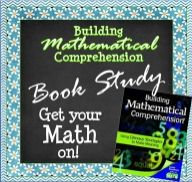
Chapter 4 is all about increasing comprehension by asking questions. I particularly enjoyed this chapter because asking questions is a huge part of reciprocal teaching, which I'm a big fan of. You can read about that here.
I also generally teach Question Answer Relationships or QAR (126) at the beginning of the year. You can read about that here. Here is an anchor chart that I use with my kiddos.
Big Takeaway: Teachers asking high-level questions does not mean that students will give high-level answers!
This was a good reminder for me to talk less and allow students to talk more.
Why ask questions?
"When students' questions drive instruction, students become more engaged and, as a result, learning is more rigorous." (116)
"When students generate questions about their mathematical work, it promotes deeper, more complex understandings."(118)
How do mathematicians use questioning? (120)
1. Before, during, and after working on math problems or concepts
My job is to model good questions before, during, and after. Think alouds are a great way to do this. Don't forget to allow time for students to ask questions.
2. For a variety of reasons
I usually just ask questions of my students to check comprehension and monitor understanding. It was nice to see that students should be able to ask questions just because they're interested in the subject. Note to self: foster curiosity!
3. To find more than one answer to a question
When I was in school it was a "get the right answer, who cares if you understand this stuff" approach and that is why I struggle with math to this day. I like this option for really pushing students' understanding.
4. To guide further exploration
Remember to give more "open ended" questions that require students to explore concepts more deeply.
5. To inspire new thinking while listening to the questions of others
I really need to incorporate more math discussion in my class!
Thick vs. Thin Questions (128)
Thick Questions
- focus on the BIG picture
- begin with WHY? How come? I wonder?
- answers require a lot of discussion and exploration
Thin Questions
- used for clarification of concepts and/or words
- have literal answers
- simple yes and no answers
- don't extend thinking
How to Teach Meaningful Questioning (131)
Start by holding small-group strategy sessions. Focus on the strategy not the skill. Small groups allow you to meet the needs of your students more precisely.
The following can help create an inquisitive environment in your classroom:
- Thinking Stems- these help get those questions juices flowing
- Wonder Walls- students post questions on a chart before, during, or after a lesson
- Question Journals- have students keep a journal of questions AND answers that they find during mathematical investigations.
- Question Webs- a graphic organizer where students pose a question in the center and contribute to the answer on stems that extend from the question. Thinking Maps translation = circle map.
- Math Stretches- small discussions that stretch students thinking
- Children's Literature- there are so many picture books that focus on math. Incorporate those for a dose of learning fun!
Chapter 4 has been a favorite so far...well, maybe chapter 2....or 1. Ok, let's face it, it's all good stuff!


I might need to get this book! I also forget sometimes to let the students talk more - "whoever does the most work does the most learning."
ReplyDeleteThis is a great post! You have really hit on the important ideas and summarized them well.
ReplyDeleteThanks for linking up.
Beth
Thinking of Teaching